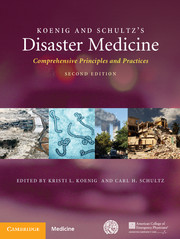Book contents
- Koenig and Schultz's Disaster MedicineSecond Edition
- Dedication
- Koenig and Schultz's Disaster Medicine
- Copyright page
- Contents
- Contributors
- Foreword
- Perspective
- Preface
- Part I Conceptual Framework and Strategic Overview
- Part II Operational Issues
- Part III Clinical Management
- Subpart IIIA: CBRNE and HAZMAT
- Section IIIB: Environmental Events
- 35 Floods
- 36 Cyclones, Hurricanes, and Typhoons
- 37 Tornadoes
- 38 Earthquakes
- 39 Tsunamis
- 40 Winter Storms and Hazards
- 41 Extreme Heat Events
- 42 Landslides
- 43 Volcanoes
- Index
- References
40 - Winter Storms and Hazards
from Section IIIB: - Environmental Events
Published online by Cambridge University Press: 05 April 2016
- Koenig and Schultz's Disaster MedicineSecond Edition
- Dedication
- Koenig and Schultz's Disaster Medicine
- Copyright page
- Contents
- Contributors
- Foreword
- Perspective
- Preface
- Part I Conceptual Framework and Strategic Overview
- Part II Operational Issues
- Part III Clinical Management
- Subpart IIIA: CBRNE and HAZMAT
- Section IIIB: Environmental Events
- 35 Floods
- 36 Cyclones, Hurricanes, and Typhoons
- 37 Tornadoes
- 38 Earthquakes
- 39 Tsunamis
- 40 Winter Storms and Hazards
- 41 Extreme Heat Events
- 42 Landslides
- 43 Volcanoes
- Index
- References
- Type
- Chapter
- Information
- Koenig and Schultz's Disaster MedicineComprehensive Principles and Practices, pp. 670 - 691Publisher: Cambridge University PressPrint publication year: 2016



